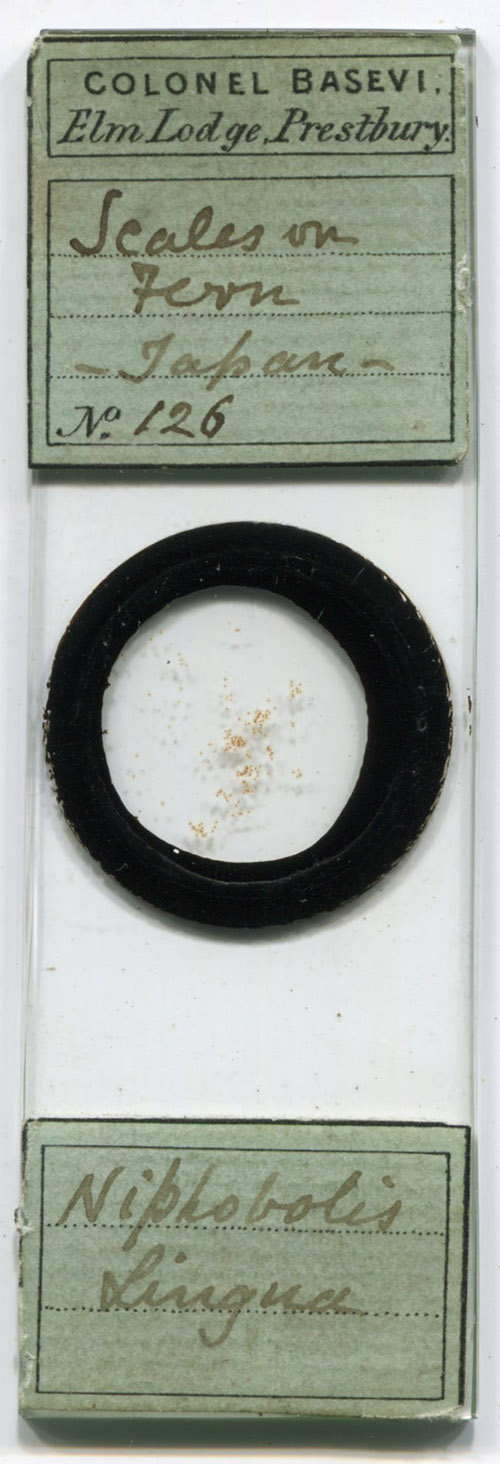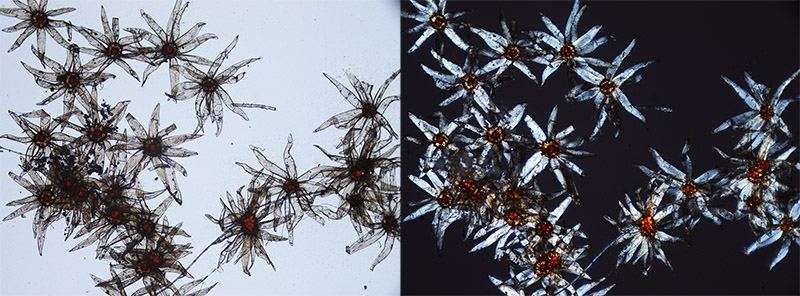
Figure 1. A microscope slide that was prepared by Colonel Basevi, of scales from the fern “Niphobolis lingua”, (now Pyrrosia lingua) from Japan. His rank and address on the label indicate that this mount was made between 1876 and 1882.
Colonel George Henry Basevi, 1830 - 1882
by Brian Stevenson
last updated October, 2016
According to his letters, Basevi was known as “Henry”, presumably to distinguish himself from his father, George. After a long service with the English Army in India, Basevi retired in 1876 to Prestbury, Gloucestershire. He quickly became involved with English scientific societies, including the Quekett Microscopical Club, The Postal Microscopical Society, and the Cheltenham Natural Science Society. All of his known microscope slides bear labels with his rank of Colonel and address in Cheltenham (Figure 1), and thus date from the six-year period between his retirement in 1876 and death in December, 1882.

Figure 1.
A microscope slide that was prepared by Colonel Basevi, of scales from the fern “Niphobolis lingua”, (now Pyrrosia lingua) from Japan. His rank and address on the label indicate that this mount was made between 1876 and 1882.
George Henry Basevi was born on December 18, 1830, and baptized on January 19, 1831 at St. James, Westminster. He was the eldest of eight children. His father, Elias George Basevi (known as George), was a noted architect. While inspecting work as a surveyor for an insurance company in 1845, father George died from falling through an opening in the floor of the west bell tower of Ely Cathedral.
Henry was appointed to the rank of Ensign / Second Lieutenant in the Royal Army on June 9, 1848. He was immediately sent to India, serving primarily as an engineer. He became a member of the Institution of Civil Engineers in 1857. His retirement record noted that, “G.H. Basevi served with the Kohat field force at the attack on the Kothul on the 12th and 25th Nov. 1853, as Assistant Field Engineer (Medal with Clasp)”. In 1872, he was “Officiating Cantonment Magistrate of Meean Meer”. Basevi rose through the officer ranks, becoming a Lieutenant in 1850, Captain in 1861, Major in 1868, and Lieutenant Colonel in 1874. His promotion to full Colonel evidently occurred just before his retirement at full pay.
A younger brother, James Palladio Basevi (1831-1870) also served in India, rising to the rank of Captain before his death from disease. J.P. Basevi is mentioned in many histories as participating in surveys of India – care should be taken not to confuse that Captain Basevi with our microscopist.
While home in 1859, “At Rugby, George Henry Basevi, esq., eldest son of the late George Basevi, esq., of Saville Row, (married) Eliza Anne, eldest dau. of the late William Pearson, esq., of Husbands Bosworth, Leicestershire”. The couple did not have any children.
As noted above, Basevi quickly became active in English scientific organizations upon his retirement. He joined the Quekett Microscopical Club on October 26, 1878. By 1881, he was Honourable Secretary of the Cheltenham Natural Science Society. Noting that Basevi’s slides which are encountered today bear printed labels with his name and address, it is probable that they were originally exchanged with other members of his various societies. For example, in 1882 he published in the Journal of the Postal Microscopical Society, “I have about four dozen duplicate slides, which I shall be glad to exchange with any member; they are very various”.
In 1881, Basevi shared an experience with slide-making, “The glycerine jelly (Dean's medium) if overheated during the process of mounting, is very apt indeed to shrink and cause vacuoles; and this shrinking occurs more readily if the object itself be not quite dry. I have had many mounts thus spoilt, but I do not give up the use of the medium, considering that due care is required not to overheat when mounting. Henry Basevi, Colonel”.
The following year, he wrote to the Postal Microscopical Society, “The nature of Starches cannot be well determined when mounted in Balsam. They should either be mounted dry or in Glycerine Jelly, and viewed as an opaque object. Mounting in Balsam prevents the markings on the surface being distinguished, and only makes a very beautiful Polariscopic object, without any scientific proofs as to adulteration, etc. Col. Basevi”.
Basevi and a Dr. Partridge shared an idea for staining woods that could be useful for microscopical examination, “I have in my possession sections taken from a piece of Larch sent me by Mr. Hyett, F.R.S., of Painswick. The wood is coloured by a process called Vital Absorption, first tried by Dr. Boucherie about 1839, with a view of testing the effects of different solutions on the durability of wood. Several different things were used. The tree from which the piece under notice was cut was first treated with a Solution of Sulphate of Iron, and then Ferro-Cyanide of Potassium. A hole was bored in the tree (while growing), just at the off-shoots of the roots; then a saw was run through to divide the tree on each side of the hole, leaving sufficient uncut for its support. A bed of clay was made round, and the Solution of Iron first poured in; after two or three days, it was replaced with the Solution of Ferro-Cyanide; absorption took place, and the chemical change followed in the tissues, forming, as is seen in my sections, Prussian Blue. This is interesting physiologically, and also to the microscopist, as showing the colouration of the structure; the most dense being only slightly stained, or not at all, and the medullary rays and vascular tissue more so. I have examined other woods, such as Beech and Elm, that have been coloured with sulphate of Iron only, but fail to detect any crystals. In the specimen referred to, the colouring matter is in the state of an amorphous deposit, an aggregation of which may be seen in places. The late Mr. W.H. Hyett experimented very largely on the effects of different solutions, and their varying effects on different trees. The softer woods were not the only ones experimented on, and, if my memory serves me, he took out a patent for the process. I think he satisfied himself that no useful result would be gained, as the staining was not uniform, and certain parts of the tree, such as the ‘medullary rays’, took the colour better than the woody tissue. The staircase of Painswick House is inlaid with the several woods experimented upon, in parqueterie work, and the appearance is pleasing”.
His last known contribution to microscopy is a late 1882 note to the Postal Microscopical Society, describing a slide of sphagnum moss that was being circulated.
An October 4, 1882, letter to Alfred Allen of the Postal Microscopical Society concluded with “Hoping that you will have a successful evening, and regretting that my health prevents my joining you”. That illness evidently lingered, and Henry Basevi died on December 15.
The next President’s Address included, “With feelings of very sincere sorrow, your Committee have to record the death of Col. Basevi, of Prestbury, near Cheltenham. The late Col. Basevi had been a member for many years, during the whole of which he took a warm and untiring interest in the welfare and success of the Society. The slides circulated by him were always of a peculiarly interesting character, his notes were always carefully and thoughtfully written, and his drawings and rough sketches were effective, and thoroughly explanatory of the subjects treated. An unfinished drawing appears in one of the note-books, testifying how great an interest he retained in the Society to the last”.

Figure 2.
Scales from a “Niphobolis lingua”, fern, from the Basevi slide shown in Figure 1. Photographed with a C-mounted SLR and 10x objective lens, with brightfield (left) and crossed polar filters (right).
Resources
Allen's Indian Mail (1848) “To rank from the 9th June, 1848, the day on which they passed their public examination, and in the following order, provided the ships by which they proceed take their departure within the period prescribed by the Court's regulations, viz. - Constantine Lawrence Yeoman. George Henry Basevi. Hamilton Maxwell. James Eobert Swetenham. Henry Thomas Sewell. Frederick William Lambert. Boyce William Dunlop Morton. Robert Henry Tulloh”, Vol. 6, page 443
Basevi, Henry (1881) Mounting in glycerine jelly, Hardwicke’s Science-Gossip, Vol. 17, page 233
Basevi, Colonel (1882) Starches, Journal of the Postal Microscopical Society, Vol. 1, pages 49-50
Basevi, Henry (1882) Notes on a slide of sphagnum moss, Journal of the Postal Microscopical Society, Vol. 1, pages 186-187
Bracegirdle, Brian (1998) Microscopical Mounts and Mounters, Quekett Microscopical Club, London, pages 12 and 112, Plate 4-QEngland census, birth, marriage, and death records, accessed through ancestry.com
Genealogical tree that includes George Henry Basevi (accessed October, 2016) http://person.ancestry.co.uk/tree/90601025/person/79016254694/facts
Gentleman's Magazine (1859) Note of the marriage of George Henry Basevi and Eliza Anne Pearson, Vol. 68, page 416
Journal of the Postal Microscopical Society (1882) Exchange offer from Colonel Basevi, Vol. 1, page 108
Journal of the Postal Microscopical Society (1882) Letter from Henry Basevi, Vol. 1, pages 197-198
Journal of the Postal Microscopical Society (1884) President’s Address, Vol. 3, page 49
Journal of the Quekett Microscopical Club (1877) “October 26 … The following gentlemen were balloted for and duly elected Members of the Club: Col. H. Basevi, Mr. J.L. Luscombe, Mr. Bernard Smith, Mr. Saml. Smith, Mr. G.H. Wallis, Mr. W. Walters, and Capt. Weatherley”, Vol. 5, page 17
The Midland Naturalist (1881) Report of the Cheltenham Natural Science Society by Henry Basevi, Honourable Secretary, Vol. 4, pages 129-132
Minutes of Proceedings of the Institution of Civil Engineers (1857) “The following Candidates were balloted for, and duly elected: Lieut. George Henry Basevi, William Christopher Bennett, Charles Percy Bysshe Shelley and Joseph Wright”, London
New Annual Army List, Militia List, and Indian Civil Service List (1872) George Henry Basevi, page 436
Partridge, Dr., and Col. Basevi (1882) Vital absorption in plants, Journal of the Postal Microscopical Society, Vol. 1, page 42
Probate of Henry Basevi (accessed through ancestry.com) “Basevi George Henry. 5 January. The will of George Henry Basevi late of Elm Lodge Prestbury in the County of Gloucester Colonel Retired List who died 15 December 1882 at Prestbury was proved at Gloucester by Eliza Ann Basevi of Elm Lodge Widow the Relict the sole Executrix. Personal Estate £583 15s 3d”